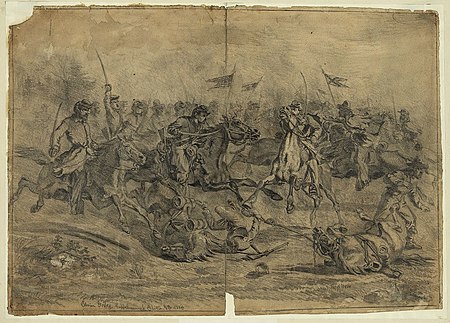In
Virginia, 150 years ago, Robert E. Lee was maneuvering his Army of
Northern Virginia in preparation for the invasion of the North that
would culminate of Gettysburg. His infantry had broken contact with
the Union forces on June 3rd
and moved northwest, leaving skirmishers from A. P. Hill and the
cavalry under J. E. B. Stuart to cover the movement. Stuart's 9,000
troopers were in high spirits. They had amazed onlookers on June 5th
and 8th
at Grand Reviews, complete with mock charges against artillery.
 |
| General Pleasonton on horseback |
But
Lee wanted his cavalry to do more than please spectators. He ordered
them to move across the Rappahannock River and raid the Federal lines
to screen his
movements. Stuart was not the only one with orders to move on June
9th.
Federal commander Joe Hooker ordered Alfred Pleasonton to take his
11,000 men across the river and foil any movements that Stuart might
be planning.
Although both forces were scheduled to move in the
morning of June 9th, the Federals began much earlier. At
4:30 am they rode across the river, surprising the few Confederate
pickets. Two Federal columns soon set off toward what they assumed
was Stuart's position. The surprised Confederate cavalry gathered
quickly and began fighting back one of the columns. The Union
troopers were surprised at the sudden resistance, as they had not
expected to meet any Confederate in that area. The southerners had
advanced closer to the river the day before so they could make a
quick start on their raid.
The Confederates holding back the Union advance
were soon surprised by seeing Federal cavalry in their rear. The
other Federal column had found an unguarded road and were able to
ride right towards Fleetwood Hill, Stuart's headquarters for the
previous night. It was directly in the rear of the Confederate lines,
held only by one cannon which had been left behind for lack of
ammunition. In this crisis, Major Henry McClellan of Stuart's staff
ordered the gun crew into action and sent word of the developments to
Stuart. This solitary cannon brought the Federals to a halt and
delayed them until Confederate reinforcements could be brought up to
strengthen the hill.
The battle continued to rage back and forth
through the day with charges and counter charges across the fields.
After ten hours the Federals finally called off the fight. The Battle
of Brandy Station was the largest cavalry battle of the war. Although
Stuart had maintained his position, he had been surprised and greatly
embarrassed. The Federals claimed victory because they fulfilled the
letter of their orders, although they did not hold the field. In the
larger scheme of things the battle was very important for the Federal
cavalry. For the first time during the war they had stood up to the
rebel troopers and fought them, horse to horse. Up to this point
Stuart had literally rode circles around them. Now they had proved to
themselves that they were nearly equal to the famed rebel cavalry. As Major McClellan said:
[Brandy Station] made the Federal cavalry. Up to that time confessedly inferior to the Southern horsemen, they gained on this day that confidence in themselves and in their commanders which enable them to contest so fiercely the subsequent battle-fields ...
This confidence would serve them very well in the coming campaign.





0 comments:
Post a Comment